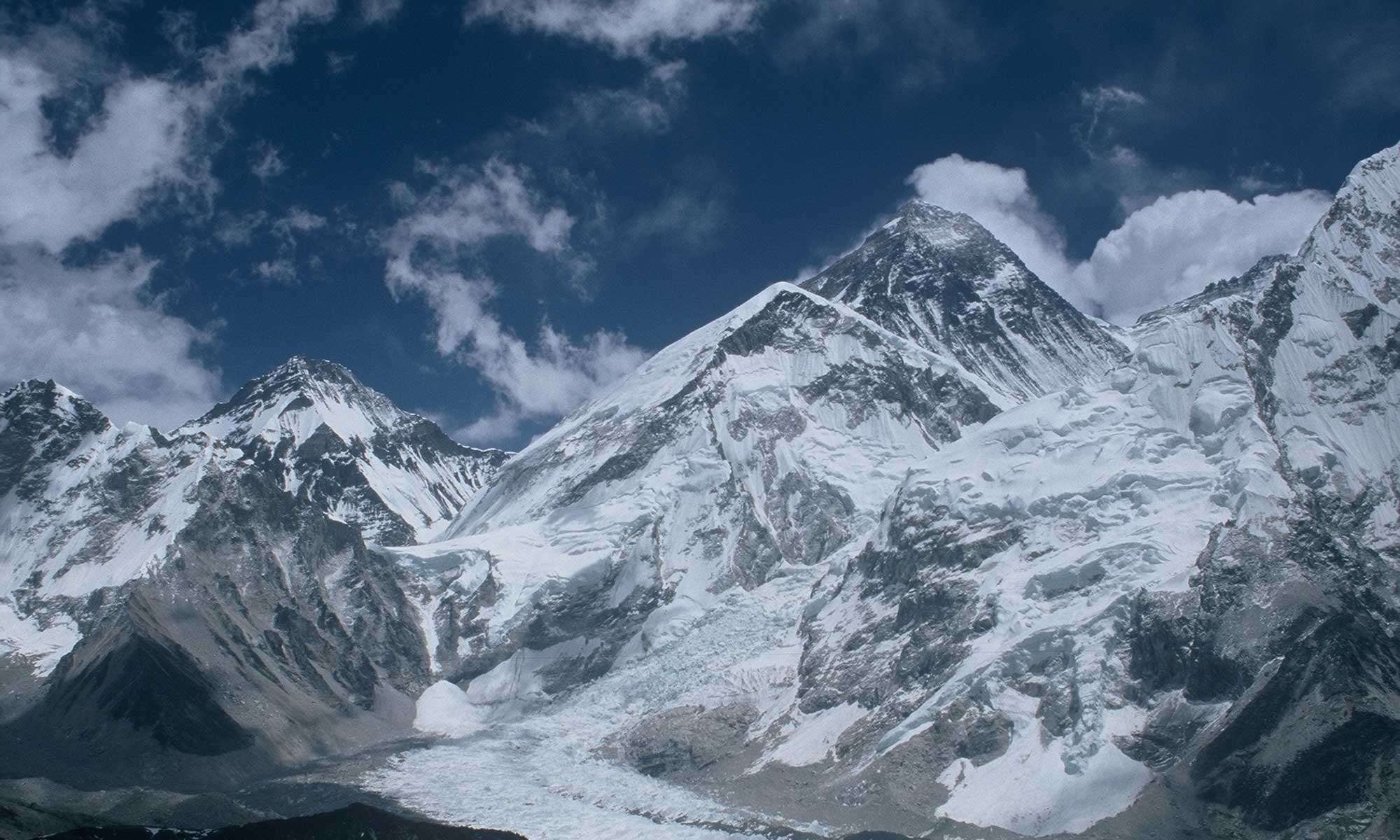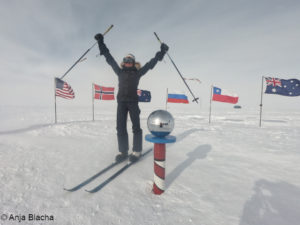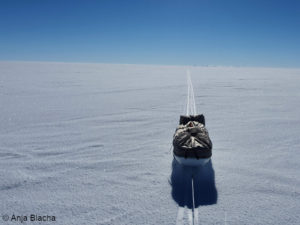57 days, 18 hours, 50 minutes of physical and mental exertion, loneliness, the endless expanse of Antarctica, crevasses, strongly fluctuating temperatures, the lowest at minus 35 degrees Celsius, severe weather, storms. Then the German adventurer Anja Blacha reached the South Pole on 9 January, overjoyed. On 12 November, the 29-year-old had set off from Berkner Island in the northwest of the icy continent. Solo and unsupported, Anja skied the distance of 1,381 kilometers to the pole, pulling her sledge, which initially weighed 100 kilograms.
From the highest mountains to the eternal ice
In 2017, Blacha, then 26 years old, had been the so far youngest German woman to scale Mount Everest, with bottled oxygen. In 2019, she was the first German female climber ever to stand on the summit of K2, the second highest mountain on earth – without breathing mask. A few weeks earlier she had already summited the neighbouring eight-thousander peak Broad Peak without bottled oxygen.
Anja Blacha grew up in Bielefeld in North Rhine-Westphalia. Today she lives in Zurich. There she works in the management of a Swiss telecommunications company, which is obviously very tolerant of her adventures: After all, last year Anja spent on average every third day on expedition. After her return from Antarctica and after Anja has recovered a little from the strains, she answered my questions.
Anja, first of all, congratulations. How do you feel after 57 lonely days in Antarctica?
Thanks a lot! Surprisingly good and everyday life catches up with you quite quickly. However, at the end of the expedition I had allowed myself a few more days at the South Pole camp and the Union Glacier as a “decompression zone” to process what I had experienced.
What were you most looking forward to when you reached the South Pole?
Doing nothing at all for a day.
Climate change and its consequences are being discussed everywhere. Were you surprised by the climatic conditions in Antarctica?
I wasn’t really surprised by the climatic conditions. For that, there have been too many changes in previous years. However, they have influenced my expedition – in the form of warm temperatures, high humidity and precipitation or extreme storms, like the one I experienced right at the beginning of the expedition. The meteorologists explained to me that they had recently observed, for example, that certain weather systems that had previously remained on the coast were moving unbraked across the continental plate, and that this year even temperatures above the zero degree Celsius mark had been measured.
You were alone in the perpetual ice for almost two months, your skis and sledge were your only companions. What did you fight with more, the physical or the psychological challenges?
During the preparation I was more concerned with the physical challenges. However, it is the head that decides how much you demand of yourself, of your body day after day, how well you keep energy and motivation over the long period of time and how you deal with the isolation. So I believe that the psychological challenge was the bigger, the more important one to master.
I personally had to fight especially when head and body did not want to come to terms with themselves and the conditions. So when the head wanted to, but the body could not. Or when I was blinded by supposedly bad conditions, so that I did not push hard enough in terms of speed, but had to put in more hours.
You summited Mount Everest in spring 2017 and Broad Peak and K2 in 2019. Can the exertions on the world’s highest mountains be compared to those in the eternal ice?
The challenges are very different. On the mountains, with the exception of the summit day, you usually have much shorter daily stages during which you have to exert yourself. You spend a lot of time in the camps and have the comfort of a fixed base camp. You take care to spend as little time as possible, to do only what is necessary for acclimatization. Many climbers’ bodies degenerate over the long expedition period. On the ascent and descent itself, absolute focus is required, and even a single misstep or a rock fall noticed too late can quickly be fatal.
On polar expeditions, however, there are practically no rest days – bad weather does not mean that you cannot and should not continue nevertheless. You are challenged every day, the whole day long, you have to dismantle the camp in the morning and to pitch it up again in the evening. You can’t take a shower for weeks, enjoy fresh food or just sit upright on a chair like you can do it all in a base camp. Instead the body gets more and more used to the permanent stress. It does not necessarily build up muscles, but a certain training effect can actually be achieved even during the expedition. And during most days it only needs a minimum of focus to stay on course, so that you have your head largely free.
Was there anything you could benefit in Antarctica from your mountain experiences in the Himalayas and Karakoram?
I benefited from my mountain experiences especially in dealing with cold and wind: I already knew what my weak points were, which I had to pay particular attention to and how I could make sure that no clothing or equipment was damaged or even flew away in the storm. Also the recognition and passing of crevasses, which I first learned in the mountains, were important for my tour.
And vice versa: What can you take from your experiences in the eternal ice for possible new mountain adventures?
For the polar expedition, I looked at the subject of weight optimisation much more intensively and how I could manage to leave nothing but footprints. Targeted planning and economical packing made it easy for me to take all my rubbish with me, and in the course of the expedition only a few grams of rubbish accumulated.
On the mountains, most people carry much more packaging material and thus also garbage with them, which unfortunately is too often carelessly thrown into the nature. Everybody would benefit from carrying less packaging material up at all, and it would hopefully be easier to take the little garbage down again later.
An example: The heat-resistant plastic packaging of a ready-to-eat meal usually weighs more than 30 grams, my bowl for eating weighs 125 grams, a thin (ideally reusable) bag weighs less than one gram. So it is worthwhile to fill up the ready-to-eat meals and eat from the bowl already from more than four main meals. And it is easier to pack in again a dry bag weighing one gram than the 30 gram original packaging, which is glued together with moist food leftovers.
Your expedition was under the motto “Not bad for a girl” – actually a chauvinist saying. Do you have the feeling that women in the adventure sector are still more likely to be smiled at rather than valued equally?
There is certainly no general answer to such a question that is quite right and fair. In fact, I have made the experience that men are more likely to be trusted to make successful expeditions. Especially on Everest, this was often communicated to me not only indirectly but also directly. When a woman does manage to do it, reactions such as “She was probably helped much more by sherpas or others”, “The goal is certainly not as difficult to achieve as people used to think” or “She was simply lucky” are often heard. And if all this doesn’t help, some strangers suspect that you might have to be particularly boyish or even a Valkyrie – only to be surprised when they meet you face-to-face (as I experienced several times).
At the same time I experience that with increasing expedition experience the prejudiced reactions decrease. In this context, I found remarkable the statement of an Austrian mountaineer on K2: He said that especially the women in the base camp would have the highest chances of success. For they had shown much more willpower and perseverance on the way there, against all stereotypes and prejudices, against which one is ultimately best equipped with absolute goal orientation, good preparation and the necessary stamina – and which they then refute with a successful expedition.
Finally, there are also those who simply pay you equal or even more respect. Or also those who have wives or daughters in their lives, who defy even clichés or for whom they wish to grow up without prejudice from such clichés. To meet the latter always gives me great pleasure. After all, they are the ones who change our society in a lasting positive way! I hope that the “Intersport” campaign (Anja was sponsored by the sports company Intersport) has also made a small contribution to this.







